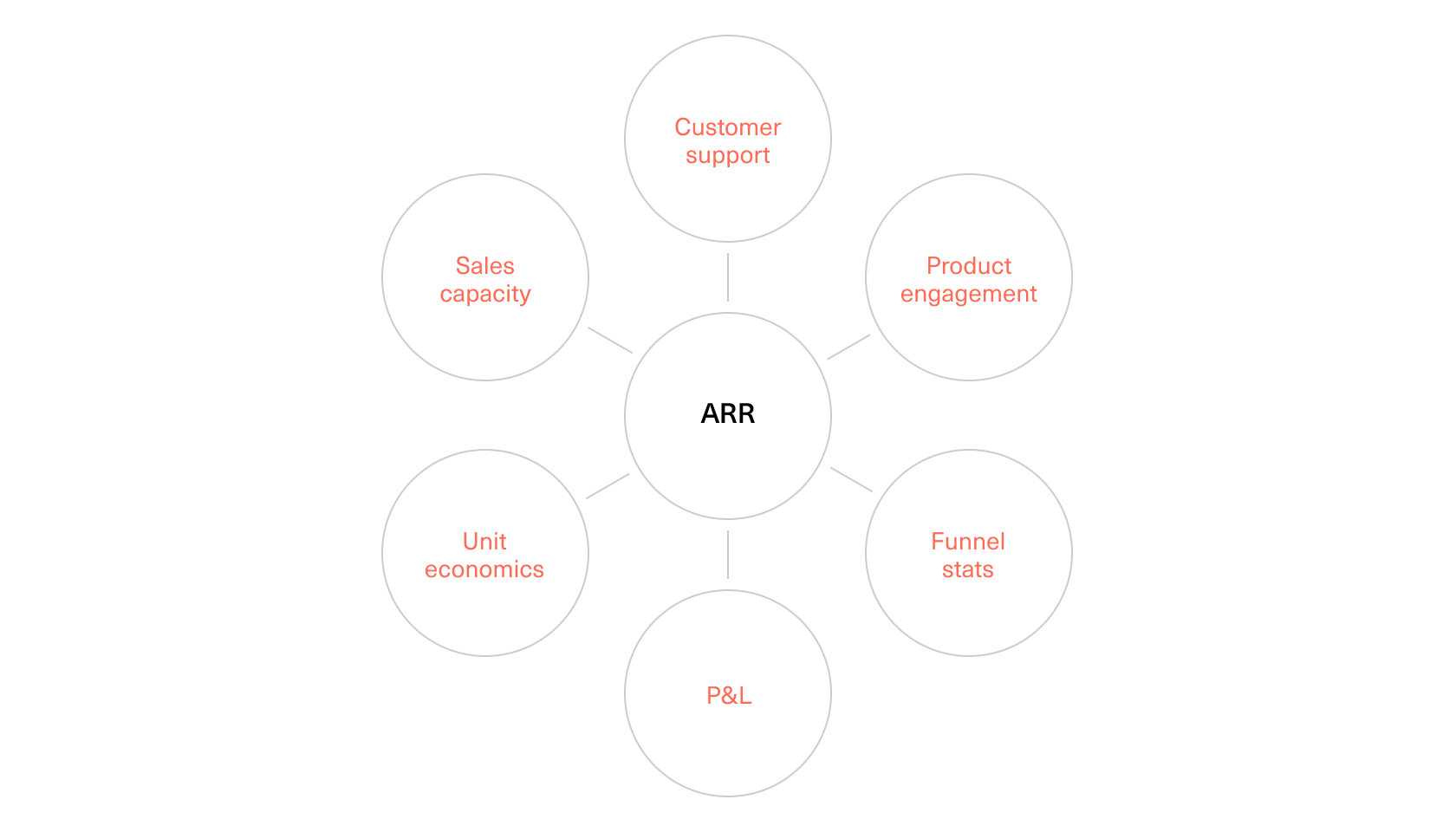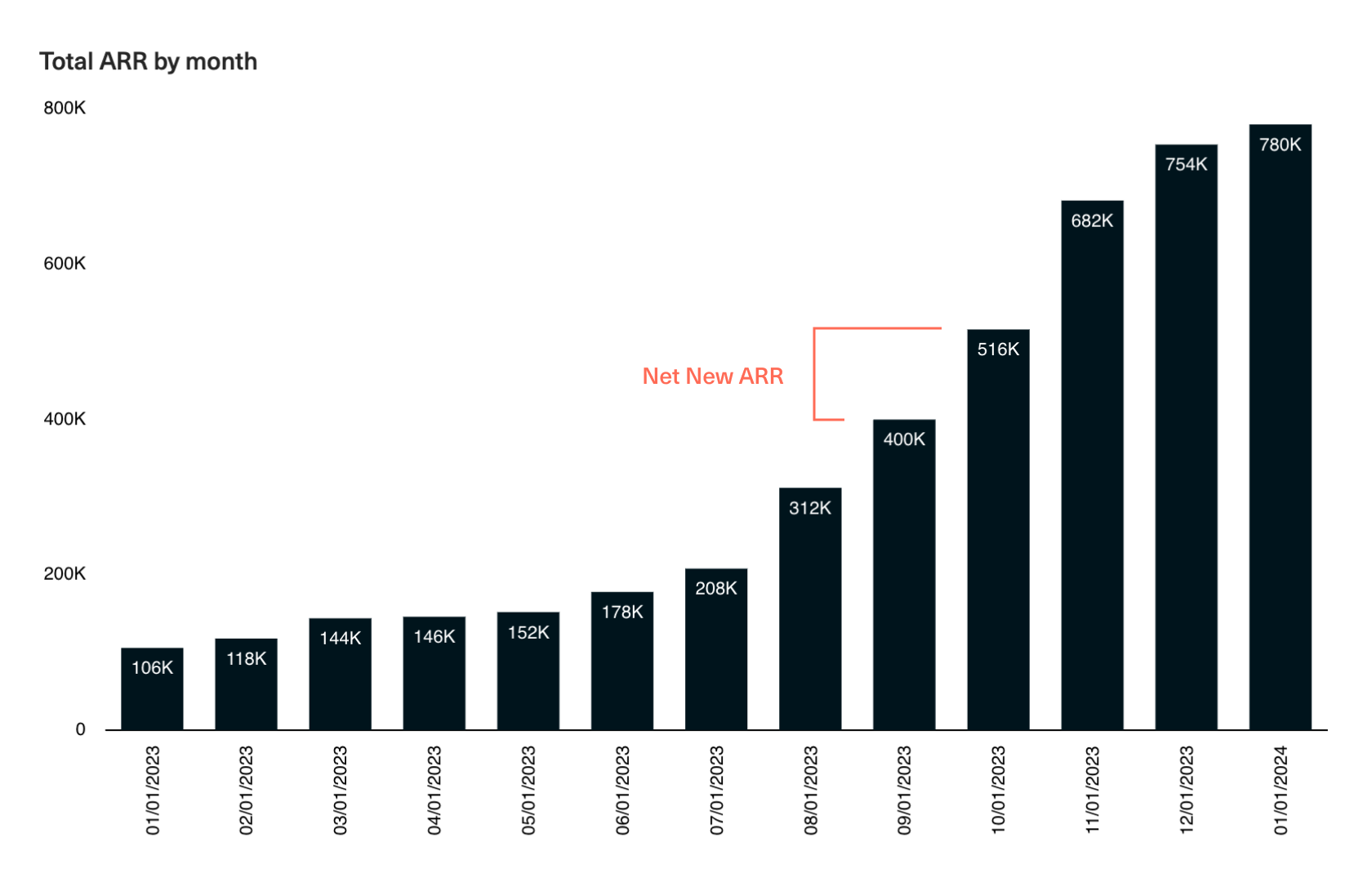The Guide to
SaaS Metrics
The Guide to
SaaS Metrics
Table of Contents
- Introduction
- Metrics to Measure
- Operationalizing Metrics
- Visualizing Metrics
- Sharing Metrics with Your Board
- Fundraising with Metrics
- Good Luck Out There
- Appendix
All-in-one GTM analytics →
Surface the levers to grow faster with live ARR, pipeline, and more.
ARR: Annual Recurring Revenue
- By
-
 Bobby Pinero
Bobby Pinero
What is ARR?
Annual Recurring Revenue (ARR) and its counterpart, Monthly Recurring Revenue (MRR), measure the recurring revenue generated by new and existing customers annually or monthly. These metrics are at the core of the SaaS business model and are indispensable for evaluating the health and growth trajectory of any SaaS business. Valuation benchmarks heavily rely on ARR — and if you don’t have a working ARR model, it’s considered a huge red flag for investors.
From an operating perspective, nailing your ARR reporting will help keep your business breathing. It will allow you to break down what’s changing month-to-month, evaluate where you’ve been, project where you’re going, and act against that understanding to improve business outcomes.
ARR reporting is also the foundation for answering nearly every other question about your business. Let’s say you want to figure out what marketing channels are working. Your first question will be whether acquired leads are converting to paid customers and whether those customers are retained. With great ARR reporting, you can answer that.
Another example? Let’s say you need to improve your onboarding flow. You’ll need to ensure that whatever you drive customers to do in-product correlates nicely with their conversion to paid and retention. Again, great ARR reporting can help you determine this.
In this way, ARR reporting is really the North Star for the business. It’s the basis for all the metrics you’ll use to optimize your funnel, improve marketing performance, drive product engagement, and everything in between.

ARR reporting starts with a solid foundation — your Total ARR, which represents the sum of all recurring revenue a company expects to receive from its customers in a year.
This sets the stage for your Net New ARR, which bridges revenue added (or lost) across periods, capturing the revenue dynamics behind directional changes in Total ARR.

From here, breaking down Net New ARR into its component parts will clearly show how customers’ behaviors impact the business.
The formula for Net New ARR looks like this:
Gross New ARR represents the revenue from your newly acquired customers - those who have started a paid subscription with your business for the first time. This makes up the vast majority of Net New ARR for early-stage companies without a significant existing customer base.
As the business grows, the balance shifts towards revenue generated from your existing customers — Expansion ARR (increases in customer spend through upgrades, adding seats, or adopting additional products) and Contraction ARR (decreases in revenue from seat reduction, plan downgrades, or dropping additional products).
Churn ARR occurs when an existing customer cancels their last remaining subscription with your business. With high churn, your business becomes a leaky bucket that needs to continuously acquire new customers to offset losses from existing customers.
On the other hand, low churn means you are extending the customers’ lifetime, retaining revenue from already-acquired customers and preserving your ability to expand their spending over time.
Finally, Restart ARR is measured when a customer who previously churned (re)starts a new paid subscription. It is generally tightly correlated with Churn ARR, and high Restart ARR is a great indicator that you’re closing gaps in your product offering that would otherwise drive churn.
| Category | ARR Component | Example Customer Actions |
|---|---|---|
| Additive Revenue | Gross New | Started a new subscription |
| Expansion |
Upgraded to a higher plan Increased seat count Bought an additional product or feature |
|
| Restart | Restarted previously cancelled subscription | |
| Lost Revenue | Contraction |
Downgraded to a cheaper plan Reduced seat count Removed add-ons |
| Churn |
Cancelled subscription Downgraded to a free plan |
By breaking out the components of ARR, you’ll paint a clear picture of how the dynamics of your customer base impact your top-level ARR metrics. You’ll also be able to align operating teams by giving them a line of sight into the levers they can pull to influence revenue outcomes.
How to calculate ARR
Creating an ARR Build involves aligning on the business logic needed to recognize and categorize revenue for your specific business accurately. This means making decisions like:
- Should we base revenue on subscription or invoice data?
- How do we define a “customer”? Do we count free customers? What about customers trialling?
- How should we handle discounts, overages, and non-recurring charges?
- What time window should we use to classify a “restart”?
Not only does defining your business logic ensure that revenue is accurately recognized, but in larger companies, this process helps you align operating teams to ensure that everyone looks at ARR in the same way and is empowered to row in the same direction. These definitions underpin many of your other business metrics, from LTV to CAC, so it’s worth taking the time to define them properly.
Constructing your ARR reporting system is a multi-step process. It starts with raw subscription or invoice data, layers on business logic, and finally arrives at a working ARR Build table that breaks out revenue movements by customer and day. This table is your single source of truth that can answer 90%+ of revenue-related questions.
Refer to The Ultimate Guide to ARR for a detailed walkthrough of building your ARR reporting from scratch — complete with SQL queries, data dictionaries, and edge case considerations.
How to optimize ARR
Optimizing ARR requires optimizing each component — maximizing revenue inflows (Gross New, Expansion, and Restart) while minimizing revenue outflows (Contraction and Churn).
| Component | Definition | Levers |
|---|---|---|
| Gross New | The total value of subscriptions from new customers. |
Increase lead volume Improve funnel conversion Increase the starting price point |
| Expansion | The total value of additional spend from existing subscriptions, e.g. add more seats, upgrade to a more expensive plan, buy add-ons. |
Pricing that better captures the value customers derive Launch new products and offerings Upsell and cross-sell campaigns |
| Contraction | The total value of reduced spend from existing subscriptions, e.g. remove seats, downgrade to cheaper paid plan. |
Improve onboarding and activation of feature sets most commonly dropped Don't oversell in the initial sale |
| Churn | The total value of cancelled paid subscriptions. |
Shore up key product gaps/issues Improve onboarding and activation Modify pricing and packaging |
| Restart | The total value of new subscriptions from previously churned customers within a given time window, e.g. one year. |
Closing known product gaps Persistence |
Gross New ARR
Maximizing Gross New ARR means building a sustainable acquisition engine focused on acquiring high-value customers (e.g., those with a high LTV:CAC) likely to convert to paid. To do this, you’ll need to get clear on your Ideal Customer Profile (ICP), how your product solves its pain points, and how you are uniquely differentiated from competitors. You’ll also want to price your product to capture as much customer value as possible without driving churn or deterring acquisition.
Ensure you keep sales, marketing, product, and growth teams in lockstep with your go-to-market strategy. Provide them with clear reporting on upstream operational metrics they can influence that feed into Gross New ARR, like lead generation, conversion, and LTV:CAC targets.
Expansion and Contraction ARR
Diligently track your engagement and activation metrics, which are a critical leading indicator for whether a customer will expand or contract in the future.
Your Customer Success and Support teams are key here. Work with them to roll out customer health dashboards that monitor response and resolution times. Build the right habits early, and they’ll pay dividends.
Tactics to drive expansion and minimize contraction involve launching upsell and cross-sell campaigns for new products and offerings and improving the discovery and activation of commonly dropped features that meaningfully contribute to the value customers derive from your product.
Churn ARR
As with Expansion and Contraction, engagement metrics are critical to understanding the value your customers derive from your product and anticipate their likelihood of churning.
To infer exactly where help is needed, you can also use a cohorted retention analysis to pinpoint where churn tends to occur in the customer lifecycle and make educated guesses about its causes.
Are you seeing lots of churn within the first few months? That points to an issue with onboarding. Maybe you oversold your product, or maybe you didn’t activate customers quickly enough to guarantee they see value early on.
Consider implementing a structured onboarding process to drive early engagement in this case. This might include personalized emails, in-product onboarding guides, case studies, best practices documentation, and early success check-ins. The goal is to ensure customers can reach the “aha!” moment with your product as quickly as possible.
Do you see churn late in the customer lifecycle? This often signals that your more sophisticated customers are reaching the limits of what your current product can provide. This trend can be concerning because these customers typically represent a significant portion of your revenue due to their larger size or higher utilization of your product.
To address this issue, it’s essential to delve into the specific needs and pain points driving these customers away. Are they seeking more advanced features, better scalability, enhanced security, or perhaps more comprehensive integration capabilities that your product currently lacks? Pinpoint those gaps and invest in closing them to improve retention over the long term.
Your Customer Success and Support teams will also be critical to intercepting the pain points that eventually drive churn. Consider creating Success programs with regular health check-ins and personalized support and implementation offerings, particularly for high-value customers.
Finally, if churn is up across the board, that points to an issue with product-market fit or pricing. You may also consider re-evaluating your ICP and tailoring your go-to-market strategy to acquire more of your ICP over time, improving the quality and retention of incoming customer cohorts.
Restart ARR
Over the long run, you’ll need to address product gaps in order to solve the pain points that are causing customers to churn in the first place. Doing this will enable you to convince those who have already churned to take a fresh look at your product with tactics like targeted win-back campaigns.
Next topic